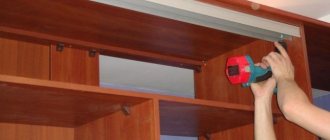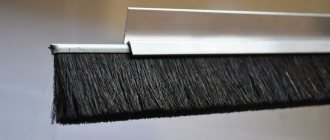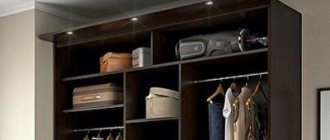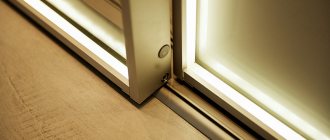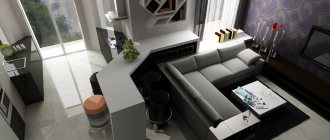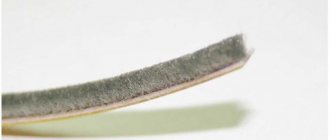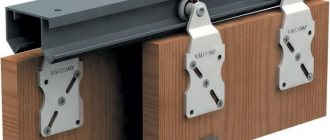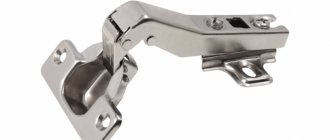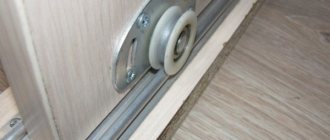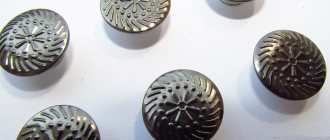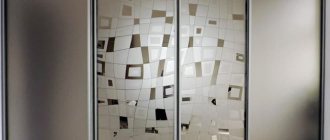Schlegel for sliding wardrobes: types of door seals, method of fastening to the profile
The side walls of sliding wardrobes are usually made of chipboard, MDF, laminated chipboard, natural wood, and the door frame is made of aluminum profile. Both materials are rigid, so that when they close, their hard surfaces hit each other, producing a loud thump. To prevent this from happening, a special seal is attached to the door - a shlegel for sliding wardrobes.
The lint fills the gap between the side wall of the cabinet and the door, preventing dust from getting inside. The seal acts as a gasket that softens the closing of the doors and makes this process silent.
What is Schlegel
Schlegel is a narrow fleecy strip that is glued to the side vertical profiles of sliding wardrobe doors. Has a width from 6 to 12 mm. An adhesive layer is applied to one side of the tape, and a brush or bristle is attached to the other. When gluing, the Schlegel fits into the internal groove laid in the aluminum profile. Installation of the buffer tape can be done directly at the factory or during subsequent assembly of the cabinet.
Craftsmen may call such fittings a boot, a seal, or a shock absorber. The boot usually has a pile length of 7 to 15 mm; its main purpose is to protect against dust particles. The length of the pile of the seals does not exceed 6 mm.
What is it needed for
Schlegel is necessary when using products made from chipboard and MDF. Pile tape provides protection for sliding systems. The part is used to silently close door leaves and block the movement of house dust in or out of the closet. Without equipping the doors with a seal, a characteristic clap or knock is heard when closing.
The contact of a solid profile with the body of the product negatively affects the chipboard, leaving dents, snags, chips and other defects on the stand strips. The materials from which cabinet furniture is made do not have shockproof protection, therefore, without sealing, the side walls lose their presentable appearance after six months. Schlegel allows you to extend the service life of the sliding wardrobe.
Main functions of the seal:
- Serves as a shock absorber when closing doors. Protects against the formation of defects on the side pillars. Provides smooth closing of doors.
- Protects from dust. About 70% of closets are used to store clothes and bedding. If the doors are not closed tightly, gaps remain through which dust particles can easily penetrate into the cabinet. The seal will reliably close the cracks.
- Noise protection. An important function if there are small children in the apartment. Silent opening will allow you to get clothes out while your child is sleeping without knocking or popping.
New cabinet designs often feature glass and mirror doors. Acrylic glass can withstand impacts, while ordinary quartz glass can crack under strong external influence. Tempered glass has critical points at the ends, and even a light blow to one of these points will lead to multi-link destruction of the panel.
What is it made from?
At first, shock-absorbing gaskets for doors were made of felt. The material has good characteristics, but is not durable. Today, the market share of felt models has decreased by 20%. Synthetic polypropylene tapes of varying densities predominate.
The seal is available in several colors that are as close as possible to the shades of the aluminum profile. After gluing, the Schlegel is practically invisible on the surface of the material. Manufacturers, at their discretion, can change or supplement the color scheme of products.
Often on sale you can find ribbons of the following colors:
- golden;
- silver;
- bronze;
- beige;
- brown.
The brush is made from polypropylene. An adhesive layer is applied over the material, covered with protective paper tape.
Pile and felt are used to make bristles. The first option is considered the most optimal; it is manufactured in different sizes and creates an excellent barrier against noise. Felt tape is also good, suitable for small gaps, but has a thick brush that does not allow you to close the doors securely.
Types of seals
For sale, sealing tapes are supplied in the form of rolls, and furniture buyers receive them in the required quantity.
There are several varieties:
- Brush buffer. It is a 7 mm tape with a pile no more than 6 mm high. Softens the impact when closing the cabinet. Has a self-adhesive base.
- Anther. Products made of polypropylene have a width of 6 mm, a self-adhesive base and a pile up to 12 mm high. Felt tapes come in different types, the length of the pile reaches 15 mm, you can buy both self-adhesive models and tapes with clips. In some anthers, the pile is clamped into a plastic molding. Inserted into a special groove in the profile.
- Wide ribbon. Intended solely for impact protection. The width of the tape starts from 11 mm, while the pile is no higher than 4 mm.
The period of operation, price and other characteristics depend on the height of the fibers and the level of their density: the higher these indicators, the more expensive the Schlegel is and the longer it lasts. According to the manufacturing technology, the pile is applied to the surface of the tape in lines, the density of the brush depends on their quantity.
Density levels:
- middle - consists of 3 lines and is marked as 3P;
- standard - 4 lines of pile, marked 4P;
- super dense - 5 lines, its marking is 5P.
How to install it yourself
The design of the strip brushes allows them to be installed horizontally, vertically or at different angles. It is important to choose the right Schlegel. The brush seal must be as compatible as possible with the door structure; the height of the pile must correspond to the width of the gap.
In sliding systems with a large number of sections, it is worth using buffer tapes with long pile. They will reliably protect against dust getting into the closet. The seal is glued to the back side of the vertical profile. Anthers are attached along the edges of the central section between two guides.
The self-adhesive base is installed in 3 stages. First, the side profile is degreased with an alcohol-containing solution. If there is glue left from the old Schlegel, then it is necessary to clean the surface more thoroughly.
When gluing, you only need to separate the protective tape and evenly place the schlegel around the entire perimeter of the sash. To make the tape easier to fit into the groove when gluing, fix it with one hand, and remove the paper layer with the other.
At the bottom, the seal is cut to the length of the door.
In profiles where the Schlegel is additionally fixed, fastening clips are installed.
You can fix the seal using regular superglue.
Watch a video on how to glue Schlegel to the door surface of a sliding wardrobe.
Thank you, Dmitry! I did it!
Hello, Olesya! Happy for you! Continue furnishing your home. I will definitely help you.
I would like to thank the author for this article. We made the doors for the wardrobe ourselves for the first time. My husband entrusted me with the calculations. (before this, I only had to calculate the details of cabinet furniture) Honestly, it was very scary, and it was scary to mess up with the dimensions. Considering the cost of profiles, this would be very sad in case of failure and miscalculation. Of course, you can find an automatic calculation for a specific system, BUT I wanted to understand how and where all these numbers come from, and the principle of measure 100,500 times and then cut has not been canceled. I calculated both automatically and manually according to the described scheme, I understood the whole principle of calculation. The only thing I would add is that if you use a buffer tape, then you need to take into account its width for the calculation so that the handles of the front and rear doors end up lying perfectly one behind the other. I saw this moment in another article from another site. This is the only thing I changed in the calculation. And so, thank you very much to the author! With such a description, you can actually calculate the dimensions for any sliding system, understanding the basic principles of calculation. it’s really very simple, everything worked out and came together down to the millimeter, there’s nothing to complain about.
Purpose of a schlegel for a sliding wardrobe, what types there are
A useful element in assembling and operating cabinet furniture is the sling for sliding wardrobes, which serves to carry out the sealing and cleaning functions of sliding systems.
It is useful during the operation of compartment doors, ensuring quietness and durability. Read also: Adjusting sliding wardrobe doors with rail running
What is
At first glance, Schlegel looks like an ordinary narrow tape with an adhesive layer. However, if you have experience in assembling cabinet furniture, namely sliding wardrobes, then it is not difficult to determine the purpose of the Schlegel. The part is used to ensure silent closing of the doors of sliding systems.
If manufacturers did not equip the doors with a schlegel, a characteristic bang would be heard at the end of the system closing. The characteristic sound would not only disturb the peace of the household at any time of the day, but would negatively affect the inside of the cabinet product. Without a seal, the sliding system quickly fails, leaving snags, dents and other defects on the pillar bars.
To understand what Schlegel is, it is necessary to consider its characteristics:
- appearance - a narrow tape, 12 or 6 mm wide, according to its intended purpose, having an adhesive layer on one side. The other side of the schlegel is equipped with a special brush, which ensures smooth closing of the sash;
- other names - manufacturers call Schlegel differently: fleecy tape, buffer tape, boot, seal, shock absorber. If in a showroom a buyer is asked about equipping a cabinet with these devices, the consultants mean Schlegel;
- location - the Schlegel is installed on the internal groove of the aluminum profile, the handle of which is used to extend the system.
The manufacturer can install the device directly at the factory. This is also done by the wardrobe assembler after finishing the work.
Varieties
In a wide variety of components for sliding wardrobes, the use of this part is necessary. It performs irreplaceable functions for the proper operation of the system. Today there are several types of devices.
| Name | Pile height | Base type | Possible colors |
| Brush seal on pile | 6 mm | Self-adhesive base, 7 mm wide | White, milky, beige, bronze, black |
| Schlegel on pile | 12 mm | Self-adhesive base, 6 mm wide | Grey, bronze, white, beige |
| Brush seal on felt | 9-15 mm | Without adhesive base, 5 mm wide | GREY-black |
| Schlegel on double pile | 4 mm | Self-adhesive base, 11 mm wide | Black, beige, brown |
The table shows approximate colors; depending on the choice of the manufacturer, they may be supplemented with other shades. Seals are sold in rolls, and consumers receive them in the quantity necessary to cover a cabinet door. Regarding the cost of the device, it is important to note: the higher the layer of pile and bristles, the more expensive the schlegel will cost.
To tape a sliding wardrobe yourself using tape, first degrease the surface of the profile.
Felt
Vorsyanoy
Self-adhesive
Functions
The widespread use of Schlegel for sliding wardrobes in the furniture industry is no coincidence: the part carries an important functional load in the operation of furniture. The fluffy tape glued to the aluminum profile ensures reliable operation of sliding systems. In particular, Schlegel performs the following functions:
- depreciation when opening and closing the doors. In the absence of this device, the door will constantly hit the counter bar from the inside. Over time, this will cause significant defects in the form of chips and cracks in the chipboard. Schlegel copes with the task perfectly, ensuring smooth closing of the compartment doors;
- protection from dust - if the door does not close tightly, then gaps appear at the joints of furniture panels. Dust and dirt accumulated in the apartment easily penetrate through them. The constant accumulation of dust leads not only to contamination of things, but to the fact that household members develop allergies. Sealing tape will easily help hide the gap and prevent dust from getting inside;
- noise reduction - this function is important if there are small children in the house. Often, a mother needs to open the closet in order to get clothes while the baby is sleeping. Cushioning will help prevent the characteristic knock and prevent noise and popping.
In high-quality furniture, a special groove is cut out on the aluminum profile into which the buffer tape must be glued. Standard manufacturers do not prepare such conditions for installation; the tape must be glued directly to the profile.
Schlegel can be attached with glue
Cut off the excess
What materials is it made from?
Today, brush seals are produced in several colors that are as close as possible to the shades of the aluminum profile of sliding wardrobes:
- golden;
- silver;
- bronze;
- brown
The material from which the miracle brush is made is called polypropylene. An adhesive layer is applied to it and the consumer only needs to peel off the protective paper and evenly distribute the tape along the desired perimeter of the sash. To do this more accurately and evenly, it is recommended not to peel off the entire paper layer at once, but to evenly separate it as you stick the brush.
Felt or bristles are used for bristles. The second option is considered optimal, as it is produced in several sizes and will have an excellent noise barrier. Felt tape is also good, but the thickness of the brush does not allow you to close the door securely, so it can be used for small gaps.
It is necessary to select the color of the Schlegel for the coupe according to the color scheme of the furniture and the shade of the profile - this way the materials will look more harmonious.
The right approach to choosing a brush seal
To purchase a brush seal that will be compatible with the door structure, it is important to take into account the door dimensions and operating clearance. The design of strip brushes allows you to install them horizontally, vertically, at different angles, based on the required size. Adhering to economy, connection is allowed. The height of the pile directly depends on the width of the gap.
A number of functions that the brush seal has:
- The density of the doors to the side walls of the cabinet. The design of the sliding wardrobe assumes the presence of working gaps, and there is no escape from this; the brush does an excellent job of sealing.
- The brush, together with the sealing functions, plays the role of anther. One should not overlook the fact that the pile also traps moisture, preventing it from getting inside the cabinet.
- Brushes on the end of the door facilitate its soft closing. The tape acts as a buffer and is able to absorb sharp impacts, preventing possible damage to the cabinet.
Assembling sliding doors of a built-in wardrobe with your own hands
Let's start assembling the sliding doors (compartment doors) of our built-in wardrobe. The assembly sequence is as follows:
Assembly of sliding doors
Below is a simple way to assemble sliding doors for a built-in wardrobe in an apartment.
All parts of aluminum profile sliding doors must be pre-fabricated.
The door assembly sequence is shown in the animation.
- Take a fill sheet made of 10 mm laminated chipboard
- We put the top profile on the filling sheet
- We put on the lower profile
- We put on the side profile on one side
- We connect the vertical and lower profile with a self-tapping screw
- Install the lower roller with the adjusting screw
- We screw the self-tapping screw halfway into the upper part of the door frame
- Insert the upper rollers on one side and tighten the self-tapping screw
- We put on the side profile on the other side
- We connect the vertical and lower profile with a self-tapping screw
- Install the lower roller with the adjusting screw
- We screw the self-tapping screw halfway into the upper part of the door frame
- We insert the upper rollers on the other side, tighten the self-tapping screw
Now about each stage in more detail.
We install the top 2 and bottom 3 profiles on the door infill sheet made of 10 mm laminated chipboard 1, having previously marked the infill sheet at the top and bottom so that the profiles fit exactly in the center. The top and bottom profiles should be shorter than the fill sheet at the top and bottom - this is shown in the animation.
If you can’t immediately place a profile on a sheet of chipboard, you can see how to overcome this here.
We place the laminated chipboard filling sheet with the upper and lower profiles installed on it on the floor - on its side. We put a vertical profile 4 on top of the laminated chipboard sheet.
Screw self-tapping screw 5 into the lower profile of the frame.
We install the lower roller 6. The roller should be located like a leaf spring inside the frame and “look” inside the door, otherwise it cannot be installed.
We screw the adjusting screw into the lower roller housing through the side profile.
We set the adjusting screw to the “middle” position - this will further simplify the height adjustment of the installed doors.
We screw self-tapping screw 7 into the upper part of the frame until its head is inside the profile approximately in the middle between the outer wall of the side profile and the jumper (see photo).
Install the upper roller 8. The roller should “look” towards the outer part of the door, do not confuse it.
We tighten the self-tapping screw until it stops until its head presses the upper roller bracket to the jumper.
Read also: Types of rollers for sliding doors
Turn the laminated chipboard sheet over to the other side and put a second vertical profile on it. We fasten the profile and rollers 9 - 13 on the other side of the frame as described above.
We assemble the second door in the same sequence.
Now you can stick a brush seal (schlegel) on the door.
Gluing the brush seal (schlegel)
For my doors I used schlegel with a pile height of 6 mm. This is a recommendation from the company where I purchased the profile.
Schlegel is a strip about 9 mm wide with a fairly rigid, inelastic plastic base, covered on one side with a thin pile.
An adhesive composition protected by film is applied to the other side of the base.
Schlegel is sold by the meter - how much Schlegel you order, that much will be unwound from the roll and cut for you.
How to stick the Schlegel can be seen in the photo. Schlegel is glued in a whole strip along the entire length of the vertical profile - without indents, and does not hang over the edge, that is, exactly the same length as the vertical profile.
Before sticking, you don’t need to cut a piece of the estimated length from a whole skein of Schlegel, because you can easily make a mistake.
Therefore, it is better to stick the schlegel by gradually unwinding the entire skein, cutting off the excess after the schlegel is completely glued to the vertical profile (see photo).
We start gluing the Schlegel from either end of the vertical profile, add it to the other end, and cut off the Schlegel along the cut of the profile.
In order for the Schlegel to stick evenly, it is better to stick it gradually, centimeter by centimeter. Then it will turn out beautiful.
After sticking, the Schlegel will begin to peel off at the edges. This is normal and occurs due to the fact that the base of the schlegel is rigid, and before the sticker the schlegel was rolled up with the base facing out.
Another reason for peeling off is the presence of holes on the edges of the vertical profile for self-tapping screws and adjusting screws of the lower rollers. For example, in the photo you can see how in my wardrobe the schlegel partially came off at the top of the installed door within 24 hours.
Peeling off of the Schlegel can be eliminated. In the upper part of the door, approximately 8-10 cm of Schlegel can be immediately “added” to the profile with “Moment” glue (preferably transparent).
At the bottom of the door, the schlegel can be secured to the vertical profile with special clamps, but it is better to install the clamps after the doors have been installed and adjusted.
If you can’t purchase special Schlegel clips, try using paper clips instead. They will be invisible in the pile.
Now you can proceed to installing the doors.
Author of the text Vladimir Naumov Update date: 09.24.2016
More on the topic:
Fastening process
Let's get started with the work:
- First of all, it is recommended to prepare the workplace. It is better to place the door on some kind of flooring, so as not to worry about the surface of the floor or table on which the work will be performed.
- On the door you need to draw the correct placement of the mirror using a template. If you glue it unevenly, it will ruin the appearance of the cabinet.
- Let's move on to degreasing the surface: to do this, wet a rag with a special solvent and apply it to both surfaces that will be bonded in the future. Moreover, when working with a mirror, you need to be extremely careful so as not to damage it. To do this, it is recommended to spread some kind of blanket and only place our workpiece on it. And then start treating the back of the glass with a degreasing agent.
- Insert a tube of silicone into the gun, cut off its edge and you can start applying the product to the surface. It is better to do this in a zigzag pattern in increments of no more than 10 cm.
- As soon as silicone has been applied to the back side, the workpiece must be placed on the door according to the drawn marks. To do this, it is recommended to place the edge of the glass in the drawn corner and align the sheet along the side line. If the mirror blank is large, it is better to use the help of a friend.
- The glass is gently pressed against the surface of the door. Care must be taken to ensure that it does not move or warp. All lines along the mark must coincide with the edges of the workpiece.
- The final fixation on the door will occur in a day. During this time, you need to place heavy objects on the surface that will improve the adhesion of the materials. The main thing is that it is a uniform load.
After gluing the mirror, wait a few minutes to check that it is securely attached.
Fittings for sliding wardrobes: what they are and what they are intended for
In a rare apartment you will not find a wardrobe that allows you to store a lot of things and save space due to sliding doors. To assemble any wardrobe you need skillful hands, a diagram and a set of parts. The set includes large components: doors, sides, shelves. And to connect them together you need small, but no less important components.
Fittings for sliding wardrobes are those small details without which it will not be possible to make full-fledged furniture. Otherwise, it will not fully perform its intended functions. The brand and model of the part affects the quality and service life of the cabinet. Let's consider the types of guides, rollers, stoppers, sliding systems and auxiliary mechanisms. Let's talk about the rules for choosing components.
TopLine XL set for two doors - silent mechanism EB 30
Purpose
Fittings - elements for connecting parts, lifting mechanisms, devices for expanding the functionality of furniture. This includes hinges, handles, holders, closers.
The accessories are intended for:
- body assemblies;
- installation of sliding doors;
- efficient operation of boxes;
- cabinet filling;
- fixing door leaves, protecting against swinging open or spontaneous closing.
For example, when assembling a cabinet, you can make changes to the filling and diversify the standard set with additional fittings, if space has been provided in advance for these purposes.
List of components
The standard set of furniture fittings for cabinets with sliding doors includes the parts presented in the table:
| Guide profile - fixed in the upper and lower parts of the body, firmly holds the doors in a vertical position and allows them to slide to the sides. |
| A door profile is a frame that frames the doors around the perimeter. |
| Rollers - installed on the door, facilitate easy opening and closing. |
| Stoppers—attached on both sides of the profile, slow down the movement of the leaf as it approaches the walls, and fix the position of the doors. |
| The seal is a soft tape that is glued to the side walls of the doors, dampens noise and vibration, prevents dust from entering the cabinet and protects the doors from knocking on the body. |
| A sliding system is a type of mechanism for moving doors. |
| Handles are mortise, the fastening of which occurs by milling the facade. They are made in round, oval or rectangular shapes. To save money or make it impossible to insert, the role of handles is often played by the door profile. |
Now let's study each element in more detail.
Profile
It represents the frame of the door leaf. At the same time, the vertical bars can serve as handles. There are two types of profiles on the furniture market:
- Steel - domestic manufacturers make it from sheets with a thickness of 0.3-0.8 mm. The thinner the sheet, the lower the price. Included in the “economy” category, the choice of colors is limited. The main disadvantage of a steel profile is that it bends easily. Also, heavy weight imposes a limitation on the size of the doors.
- Aluminum is strong and rigid, it can be anodized or in a PVC shell. Durable coating, price higher than steel. Aluminum profiles are easy to match to cabinets of any color. The low weight allows the production of doors up to 3200 mm high.
The anodized coating of the aluminum profile is scratch-resistant and lasts for decades. The door is light and durable.
Guides
Each sliding wardrobe is equipped with two guides, which are placed above and below the door. Steel, plastic or aluminum are used in production.
The guides look like a metal profile with grooves in the center. A roller moves along them.
Bottom sliding wardrobe guide
Depending on the number of doors, sliding wardrobe guides are:
- single-lane;
- two-way;
- three-way.
The choice of type depends on the mechanism, and installation is done using wood screws.
Rollers
They are responsible for moving the door leaf and its smooth sliding when opening. They consist of a base and wheels that move along guides. The quality of the rollers determines the softness and smoothness of movements when operating the door. Most models are equipped with bearings that reduce noise levels.
The material for the roller rims is rubber, plastic, steel or Teflon. The rubber version is the best because it is completely silent.
Structurally, there are two types:
- Asymmetrical - designed to move the sashes along the bottom guide. The upper wheel supports the door, the lower one is a support. This element is used for doors with an open handle. This type of roller is height adjustable.
- Symmetrical - located on the same level as the door, due to which the door leaf is recessed inside the cabinet. This option is mounted in wardrobes with a plastic, glass or mirror facade.
The lower rollers are needed to support the doors and adjust the door leaf in height and inclination.
One corner can rise relative to the frame to a height of up to two centimeters. The number of rollers is selected depending on the weight of the door leaf. Read also: Which is better, film or glass?
Additionally, read about adjusting sliding doors yourself.
When choosing videos, look at their quality. The symmetrical option will allow you to install the door without distortions.
Stopper
The list of spare parts for the wardrobe includes a stopper, also known as a positioner. The first option is installed on the lower guide and acts as a door lock when it opens. The stopper is a metal bar with springs on it. It works according to the following scheme:
- the door opens by moving the roller along the bottom guide;
- the wheel fits onto the stop plate;
- the roller enters the space between the stopper plates, as a result of which the door is fixed.
There are also top-mounted limiters used in hinged sliding systems. In this case, the stopper is made of rubber and is made in the form of a bar, which is inserted into the ends of the guides.
Suspension systems use a rubber stopper
Sealant (schlegel)
To prevent dust from inside the cabinet and to ensure a tight fit of the panel to the cabinet, a damping tape is installed around the perimeter of its doors.
It comes in silicone, polyurethane and brush. The first two options are more often used with aluminum profiles. They muffle noise when doors move. Such seals are reliable and safe for health, since they are made from environmentally friendly raw materials.
Silicone seal
Brush buffer tape consists of an adhesive base and a fleecy layer. Manufacturers use it against dust and to soften door impacts.
Closers
Mechanisms for sliding systems for smooth closing of doors. You push the door in the desired direction, and the door closer does the rest of the work. The doors close silently and without knocking on the side walls.
They are used mainly in premium furniture. Able to support a door of any weight made of chipboard, MDF, glass or mirrors. Closers can also be installed on a finished cabinet without changing the design or requiring disassembly.
Similar equipment is also used for boxes. These ball guides look like regular runners, but are additionally equipped with a finishing system. The price for such models ranges from 400 to 900 rubles per pair.
Sliding systems
This is the mechanism that ensures the operation of the door leaf. The sliding system is divided into two types:
- support - the load in this system is taken by the lower guide, the upper one acts as additional assistance. It is easy to assemble and reliable, suitable for large-sized door panels.
- hanging - the main guides are the top ones, the door is attached to them. The bottom profile may be missing. It is characterized by quiet opening, low price and the ability to be used on doors without a profile.
Hanging systems for sliding wardrobes are convenient, but require frequent adjustment. Support ones are considered more durable.
The popular Versailles system is installed in most cabinets.
When the opening is too narrow for installing a sliding system, manufacturers use a rotating mechanism (also known as a pivot), most often for wardrobes with a corner section.
Pull-out fittings
The cabinet is filled with pull-out elements that are mounted on the following types of guides:
| Roller ones are the most popular on the cabinet furniture market. Allows loads up to 25 kg. They come with a door closer included. |
| Ball - movement in them is carried out due to balls in the profile. The advantage is easy opening of the drawers and a variety of sizes. |
| Metaboxes are a system with roller guides and drawer sides made of steel or plastic. Can be extended fully or partially. They come in different sizes and differ in filling elements. |
| Tandems are guides that are hidden inside the drawer. When using such a system, the entire space of the cabinet is used with a gap of no more than 4 mm. The advantages include noiselessness and a variety of components. There is only one drawback - high cost. |
The filling depends on the functions of the cabinet and your budget.
Filling elements
For dressing rooms, fittings are produced that allow you to neatly place clothes, shoes and other items. The convenience of the closet depends on it. Let's consider the main details of such accessories:
| Horizontal rod - a metal pipe designed for hangers, which is attached between the walls of the cabinet. |
| Pull-out hangers are installed across the cabinet. They look like barbells and can be stationary or retractable. |
| A retractable trouser holder for a wardrobe is attached to its rear or side walls and comes in several configurations. A model in the form of pins is considered convenient. |
| Pantograph. Installed in large wardrobes up to the ceiling without mezzanines, when you need to place things in two rows. At the lower level, clothes are hung on static rods. On the top one there are hangers hanging on a pantograph. This is convenient for people of any height. |
| Pull-out mesh baskets. A modern version of drawers that provides ventilation for things. |
| Shoe shelves are similar to conventional drawers, but differ in partitions for rational placement of shoes. |
| Belt holder - equipped with hooks for hanging by the buckle. |
| The tie holder is a strip with small plastic hooks. |
| Iron holder - wire retainer can withstand the maximum possible heating temperature of the soleplate of 205°C. Fastened with self-tapping screws in a separate compartment of the cabinet. |
| The vacuum cleaner hose holder is also made of wire and allows for convenient hanging storage. |
When choosing what to fill your closet, think in advance about what will be stored in it and in what quantity.
If desired, locks can be installed on the cabinet doors to hide the contents from children. For example, the Lubby company produces latches and locks that limit the opening of drawers.
Selection rules
When purchasing fittings for a wardrobe, look at the quality of workmanship - replacing it in the future will not be easy. The service life of moving elements, the load on shelves, and ease of use depend on the quality of components. The rollers must withstand repeated door openings, and the sliding mechanism must operate smoothly and effortlessly.
When purchasing components, take into account the manufacturer’s reputation and reviews of models; do not skimp on parts. Corners, hooks, door handles, profiles for facades, in addition to their main function, also perform a decorative function.
Buy all parts from one manufacturer. This will protect against possible inconsistencies between the elements of the fittings, and therefore prevent inconvenience during operation.
The table shows manufacturers of reliable accessories whose products are on the Russian market. based on customer reviews.
| Manufacturer | Description | Made-Box |
| TOTAL | A company offering a huge selection of parts - hinges, boxes, handles, hangers. | 2 |
| ARISTO | A leading supplier of components with a network of stores across Russia. | 5 |
| COMMANDER | It produces fittings in two directions - luxury and standard. Steel profiles are used in budget cabinet models. | 3 |
| LUCIDO | Turkish manufacturer of sliding wardrobe mechanisms | 1 |
| HETTICH | A German company with a subsidiary in Russia. Operating for over 100 years. Hettich fittings are distinguished by their durability, consistently high quality and wide range. | 5 |
| BLUM | An Austrian company produces retractable systems and lifting mechanisms. | 2 |
| STANLEY | American manufacturer of furniture and accessories. Stanley specializes in door rollers; the company’s popularity was brought by its “anti-jump” technology, which ensures doors move without distortion. | 4 |
Brief conclusions
Finally, let's not forget about structural fittings. This includes hardware that is used to connect parts, canopies, install doors, body elements, guides and filling. Essentially these are screws and bolts; they must be made of high-quality metal and perform a simple fastening function.
Depending on the type, fittings can ensure the strength and integrity of the structure, expand the functionality of the furniture, and also serve as an original decorative element. It is better to immediately buy quality products from recommended brands.
Reliable adhesive composition
During the production of the tape, a special adhesive composition is used, which provides the tape with sticky properties for a long time, and even after repeated use. Adhesive testing is carried out according to the following criteria:
- Adhesive properties (parallel peel test is performed).
- Shear retention, this determines the load retention time for the vertical gluing method.
- Temperature test at which the adhesive properties begin to weaken. Can be used in cold winters, in unheated rooms.
- The glue grades comply with European requirements, this confirms reliability and instills confidence in the sealant.
Retail prices assume the cost per linear meter:
- A boot with dimensions of 7x6 mm will cost 30 rubles/m.
- A boot with dimensions of 7x12mm will cost 40 rubles/m.
- The price of the fixing clip is 15 RUR/piece.
Rich color palette
The color range offered by manufacturers is suitable for even the most daring design solutions. Colors have a palette of shades. Metallic can be used. The composition of the paint prevents fading and even the slightest change in color during use.
Monocolor is widely popular in use - when the base of the tape has the same color as the bristles of the brush. This is especially visible in the finished product; such cabinets have an expensive look.
What it is
There are different types of seals for doors and windows. If we are talking about a wardrobe and its sliding system, then in its design, probably, from the factory, schlegel tape has been laid.
If you look visually at the product, you will see a simple narrow tape with an adhesive layer. Even in the photo the material does not cause any surprise, since it looks extremely simple. But in fact it performs extremely important tasks.
If there were no schlegels on the doors even at the production stage, when closing the sliding system, you would constantly be faced with quite strong bangs. Schlegel not only protects against extraneous and strong sounds, but also prevents the destruction of the internal components of cabinet furniture. Without such a tape, the doors would quickly fail; they would develop snags, dents, and other defects.
Experienced furniture makers strongly recommend buying tape if you decide to make and assemble the compartment yourself. There is no need to buy Schlegel in large quantities in bulk. Go to the same Leroy Merlin, you can easily find a seal that costs literally 12-15 rubles per linear meter. Replacing a worn Schlegel itself is also extremely simple.
To better understand the essence of the element, it is worth looking at some of its features:
- Appearance. Resembles a narrow ribbon, the width of which is 6 or 12 mm. On one side there is an adhesive layer, and on the other there is a brush element necessary for smooth closing of the valves. It is the brush that plays a key role in the design;
- Titles. Reading reviews and various materials, you cannot always come across the concept of Schlegel, although this is precisely what we are talking about. The product has many names, including buffer tape, boot, fleecy tape, shock absorber, shockproof brush and simply seal;
- Accommodation. Schlegel is laid on the internal grooves of aluminum profiles.
Depending on the policy of the furniture factory or the design features of the wardrobe, sling strips can be installed at the production stage, or after assembly by the furniture maker.
Possible tape density
The number of lines determines the density of the pile. The denser the brush, the stronger and more reliable it is, the longer it retains its original appearance, and its high resistance to wear. Today's market includes products with the following densities:
- 3 lines - medium density, marked as (3P)
- 4 lines - standard density is marked as (4P)
- 5 lines - super dense, and is designated as (5P)
Brushes are offered in wound coils of 150 m, 200 m and 275 m, convenient for use in production or retail sales. Basically, the standard tape has a width of 7mm, height starts from 4mm and reaches 15mm. Depending on the application of the tape, overall dimensions may vary.
Varieties
Sliding wardrobes use a vertical profile, which can be created from different materials. Also, this element may differ in size, color and cost. When choosing a specific type, all these parameters must be taken into account, since if it is chosen incorrectly, this will lead to the fact that the cabinet will be inconvenient to use, and it will not last too long.
Steel
High-quality steel is often used to create the product. The resulting item has some specific features:
- affordable cost, so every cabinet owner who needs to carry out repair work associated with replacing the profile will not incur significant expenses;
- This item is presented in only one variety, therefore it is not equipped with any additional elements that increase its strength and service life;
- steel products are usually produced only by domestic production companies, so their quality is not considered too high, and they are not always suitable for interior items made in any foreign countries;
- the dimensions of such a profile can be different, so it is possible to choose the ideal model for a specific type of furniture;
- the color of steel products can be different, so you can choose a white element or some other, so it will perfectly match the color of the interior item itself for which it is purchased, but steel products are produced in a limited color palette;
- If during operation the integrity of the outer coating of such a product is compromised, then a corrosion process will begin, leading to the destruction of the structure.
Thus, steel profiles for sliding doors have both advantages and certain disadvantages, which must be taken into account before purchasing. If the buyer has a cabinet made by a German or other foreign company, then such a product may not fit this furniture
It is also important that the color of the structure be the same as the handle and other furniture elements, and due to the limited color range, it is often impossible to choose the optimal color for a steel product
Aluminum
The aluminum profile has many positive parameters. These include:
- long service life;
- resistance to corrosion;
- the dimensions of the structure may be different, so it is possible to select the optimal dimensions for a specific piece of furniture, and the width may not even exceed 16 mm;
- the color of the element may be different, so you can choose a product in white or some other shade;
- aluminum profiles for sliding wardrobes are lightweight, so their installation is considered a simple and quick job, and also does not have a serious impact on the main elements of the furniture;
- a narrow profile, the width of which does not exceed 16 mm, can have an anodic coating or can be wrapped in polyvinyl chloride, which additionally gives it greater rigidity and strength;
- Aluminum parts are offered by both domestic companies and various foreign companies, so they are perfect for almost all models of furniture.
Thus, aluminum products are considered in demand and popular
They are chosen if you need to use a thinner design, and it is also important to choose the same color as the cabinet handle on the door
